Fachartikel
Im Anschluss finden Sie eine Auswahl der von uns veröffentlichten Fachartikel.
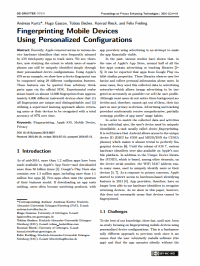
Proceedings on Privacy Enhancing Technologies (PoPETS) (2016), Nr. 1, S. 4-19
Fingerprinting Mobile Devices Using Personalized Configurations
Abstract: Recently, Apple removed access to various device hardware identifiers that were frequently misused by iOS third-party apps to track users. We are, therefore, now studying the extent to which users of smartphones can still be uniquely identified simply through their personalized device configurations. Using Apple’s iOS as an example, we show how a device fingerprint can be computed using 29 different configuration features. These features can be queried from arbitrary thirdparty apps via the official SDK. Experimental evaluations based on almost 13,000 fingerprints from approximately 8,000 different real-world devices show that (1) all fingerprints are unique and distinguishable; and (2) utilizing a supervised learning approach allows returning users or their devices to be recognized with a total accuracy of 97% over time.
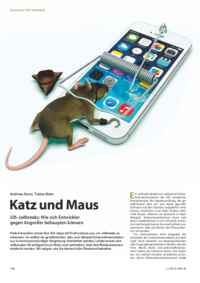
c’t 20/2014
Katz und Maus
iOS-Jailbreaks: Wie sich Entwickler gegen Angreifer behaupten können
Viele Entwickler rüsten ihre iOS-Apps mit Prüfroutinen aus, um Jailbreaks zu erkennen. So wollen sie gewährleisten, dass zum Beispiel Unternehmensdaten nur in vertrauenswürdiger Umgebung verarbeitet werden. Leider setzen sich Jailbreaker oft erfolgreich zur Wehr und verhindern, dass ihre Manipulationen entdeckt werden. Wir zeigen, wie Sie dennoch die Oberhand behalten.
Inhalte:
- Jailbreak-Erkennung
- Umgehung von Erkennungsroutinen
- Binary/Runtime Patching
- Erweiterte Jailbreak-Prüfung
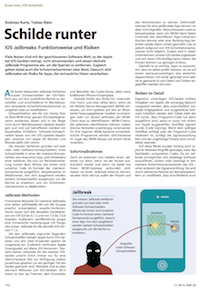
c’t 20/2014
Schilde runter
iOS-Jailbreaks: Funktionsweise und Risiken
Viele Nutzer sind mit der geschlossenen Software-Welt, zu der Apple bei iOS-Geräten zwingt, nicht einverstanden und setzen deshalb Jailbreak-Programme ein, um die Sperren zu entfernen. Zugleich gehen dabei auch die Schutzmechanismen über Bord. Dadurch sind Jailbreaks ein Risiko für Apps, die vertrauliche Daten verarbeiten.
Inhalte:
- Jailbreak-Methoden
- Risiken
- Verheimlichte Jailbreaks
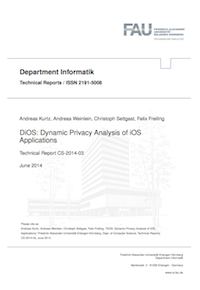
Technischer Bericht
DiOS: Dynamic Privacy Analysis of iOS Applications
We present DiOS, a practical system to perform automated dynamic privacy analysis of iOS apps. DiOS provides a highly scalable and fully automated solution to schedule apps from the official Apple App Store for privacy analysis to iOS devices. While apps are automatically executed, user interaction is simulated using random and smart execution strategies, and sensitive API calls as well as network connections are tracked. We evaluated the system on 1,136 of the most popular free apps from the iOS App Store and found out that almost 20% of all investigated apps are tracking users‘ locations on every app start, one third of all accesses to users‘ address books are attributed to apps from the social network category and almost half of all apps are tracking users‘ app usage behavior by incorporating tracking and advertising libraries.
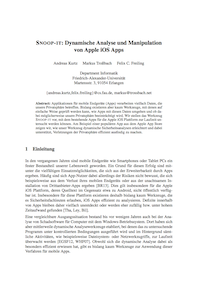
GI SICHERHEIT 2014
SNOOP-IT: Dynamische Analyse und Manipulation von Apple iOS Apps
Applikationen für mobile Endgeräte (Apps) verarbeiten vielfach Daten, die unsere Privatsphäre betreffen. Bislang existieren aber kaum Werkzeuge, mit denen auf einfache Weise geprüft werden kann, wie Apps mit diesen Daten umgehen und ob dabei möglicherweise unsere Privatsphäre beeinträchtigt wird. Wir stellen das Werkzeug SNOOP-IT vor, mit dem bestehende Apps für die Apple iOS Plattform zur Laufzeit untersucht werden können. Am Beispiel einer populären App aus dem Apple App Store zeigen wir, wie unser Werkzeug dynamische Sicherheitsanalysen erleichtert und dabei unterstützt, Verletzungen der Privatsphäre effizient ausfindig zu machen.
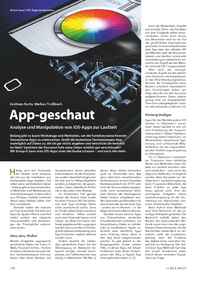
c’t 21/2013
App-geschaut
Analyse und Manipulation von iOS-Apps zur Laufzeit
Bislang gibt es kaum Werkzeuge und Methoden, um die Funktionsweise von Smartphone-Apps zu untersuchen. Greift die kostenlose Taschenlampen-App womöglich auf sensitive Daten zu und überträgt diese heimlich an Dritte? Werden die Daten von der Passwort-Safe App tatsächlich sicher abgelegt? Mit Snoop-it kann man iOS-Apps unter die Lupe nehmen – und noch vieles mehr.
Inhalte:
- Beschreibung allgemeiner Risken für mobile Apps
- Einführung in die Apple iOS Laufzeitumgebung
- Vorstellung von Werkzeugen zur Prüfung von iOS Apps
- Anwendungsfälle und Maßnahmen zur Absicherung von iOS Apps
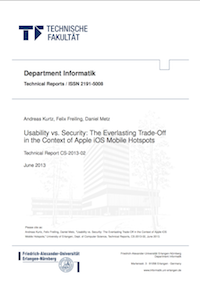
Technischer Bericht
Usability vs. Security: The Everlasting Trade-Off in the Context of Apple iOS Mobile Hotspots
Passwords have to be secure and usable at the same time, a trade-off that is long known. There are many approaches to avoid this trade-off, e.g., to advice users on generating strong passwords and to reject user passwords that are weak. The same usability/security trade-off arises in scenarios where passwords are generated by machines but exchanged by humans, as is the case in pre-shared key (PSK) authentication. We investigate this trade-off by analyzing the PSK authentication method used by Apple iOS to set up a secure WPA2 connection when using an iPhone as a Wi-Fi mobile hotspot. We show that Apple iOS generates weak default passwords which makes the mobile hotspot feature of Apple iOS susceptible to brute force attacks on the WPA2 handshake. More precisely, we observed that the generation of default passwords is based on a word list, of which only 1.842 entries are taken into consideration. In addition, the process of selecting words from that word list is not random at all, resulting in a skewed frequency distribution and the possibility to compromise a hotspot connection in less than 50 seconds. Spot tests show that other mobile platforms are also affected by similar problems. We conclude that more care should be taken to create secure passwords even in PSK scenarios.

iX 05/2011
Nicht durch die Hintertür
Einsatz von Exploit-Mitigation-Techniken
Im Rahmen dieses Artikels werden neben der Beschreibung der wichtigsten Exploit-Mitigation-Technologien unter Linux und der Vorstellung eines Werkzeugs zur Prüfung dieser Schutzmechanismen, gängige Linux-Distributionen hinsichtlich der Verwendung von Exploit-Mitigation-Technologien untersucht.
Inhalte:
- Einführung in die Problematik sogenannter Speicherfehler.
- Beschreibung der wichtigsten Exploit-Mitigation-Technologien unter Linux.
- Vorstellung eines Werkzeugs zur Prüfung dieser Schutzmechanismen.
- Vergleich gängiger Linux-Distributionen hinsichtlich der Verwendung von Exploit-Mitigation-Technologien.
